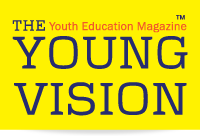
Innovation in Education – a student-centric revolution
Written by Shanel Misquitta, The Young Vision Ambassador (Since Mar 2019), Dubai Gem Private School - Dubai and Siddarth Mohan Shekhar, The Young Vision Ambassador (Mar 2019 - Sep 2019), Dubai Private School - Sharjah
Education has seen systemic paradigm shifts, the likes of which have been markedly technological in nature. The classroom – a set up that is still rampant with industrialisation-age artefacts – is having the quintessential 21st century update, in ways that have become important for youth to comprehend and familiarise themselves with.
The necessity of technology in education:
- Students are digital natives, and keeping them out of the influence of inputs they are adept with means losing out on key teaching tools and allowing them to severely lag behind the real world.
- Students can learn at their own pace, allowing for a more inclusive and specialised course for each student. This comes from the understanding that each student must have their different needs considered when teaching tools are adopted.
- Technology brings a dynamic of limitlessness, giving the freedom of expanding their horizons, to students themselves.
- It betters the teacher-student relationship, as it makes teaching more fun and meaningful.
- Testing has gone online, so by keeping learning and teaching online as well, means students are better equipped for academic success.
Getting down to the brass tacks, the technology-based innovations that students of today will see being utilised around them in a systemic and competitive way are as follows…
- Anti-bullying software: An important aspect of education is certainly a safe environment; schools are now looking at technology to provide the same, in better and more efficient ways. Softwares – BRIM (Bullying Reduction Intervention and Monitoring) and apps – KnowBullying and BullyTag, have been used widely by school administrators and by student body leaders in identifying and curbing incidents of peer coercion.
- Coding and IoT (Internet of Things) courses: Basic courses for these are being implemented even in primary schools, equipping students with what is becoming an essential ability to new millennia learners – programming computers to perform tasks and understanding the vast online sphere. This also allows for the development of a problem solving skill called computerised thinking, the honing in of which has become advantageous.
- Virtual, Augmented and Mixed Reality: VR refers to the computer-generated 360-degree first-person explorative experience that is created when a user adorns a headset. While Augmented and Mixed Reality refers to the creation of 3D elements in a user’s real environment, allowing for tremendous scope of creativity in the learning process. Though they are traditionally used for movie and gaming experiences, its breakthrough into the education sphere has been somewhat of a game-changer. With the falling prices in wearable glasses and headsets, the number of schools and organisations willing to experiment with such an immersive mode of learning, has increased. For example, InMediaStudio, makers of the Immersive Worlds Project, has created a sea-bed VR for marine biology students.
- Mobile Education: With the introduction of apps like Byjus, Khan Academy and even the language-learner’s Duolingo, students have been given new platforms by which learning can be conducted; supplementing the text book instead of replacing it.
- Cloud Technology: The ubiquity of cloud sharing has been beneficial in the seamless availability of a user’s documents across all of his/her devices. This has led to the creation of Virtual Classrooms and Training Labs, a paperless method through which teachers distribute material and assignments, and track students’ grades.
- Microlearning programs: Microlearning is a holistic approach to skill based learning that deals with objective-specific smaller learning units instead of larger modules – this has been proven affective to a large extent, especially for students with lesser concentration spans, an increasingly larger fragment of the student populous. The advancement of this technique has been largely through videos, scenarios, white board animations and kinetic texts.
- Gamification or game-based learning: As paradoxical as it may sound, game based learning increases the ‘seriousness’ of learners as they fully immerse themselves in the process of gaming. Games, such as Kahoot!, that are well thought out, well designed and address the learner uniquely, allow for a positive studying experience, and provide for greater retention rates of the content shared.
Students that are allowed to engage in their classroom through technology…
- think outside the box
- feel safe to express innovative and creative ideas
- feel comfortable doing hands-on learning
- take ownership over their learning
- work collaboratively with others
- understand the ways that science, technology, engineering, arts and mathematics (STEAM) work together
- become increasingly curious about the world around them and feel empowered to change it for the better.
All in all, the bountiful benefits of technology have entered the field of education in a meaningful and revolutionary way. Keeping adept with these changes has become essential to teachers and students alike.
